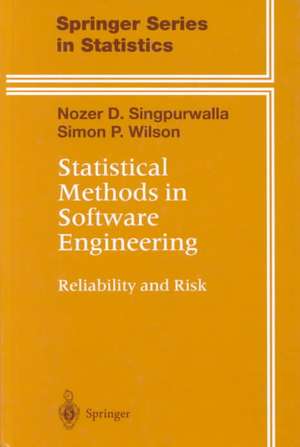Statistical Methods in Software Engineering: Reliability and Risk: Springer Series in Statistics
Autor Nozer D. Singpurwalla, Simon P. Wilsonen Limba Engleză Hardback – 5 aug 1999
| Toate formatele și edițiile | Preț | Express |
|---|---|---|
| Paperback (1) | 703.38 lei 6-8 săpt. | |
| Springer – 27 sep 2012 | 703.38 lei 6-8 săpt. | |
| Hardback (1) | 991.60 lei 6-8 săpt. | |
| Springer – 5 aug 1999 | 991.60 lei 6-8 săpt. |
Din seria Springer Series in Statistics
- 14%
 Preț: 679.60 lei
Preț: 679.60 lei - 20%
 Preț: 630.98 lei
Preț: 630.98 lei - 20%
 Preț: 816.45 lei
Preț: 816.45 lei - 20%
 Preț: 1000.85 lei
Preț: 1000.85 lei -
 Preț: 390.84 lei
Preț: 390.84 lei - 20%
 Preț: 697.14 lei
Preț: 697.14 lei - 20%
 Preț: 445.20 lei
Preț: 445.20 lei - 20%
 Preț: 884.71 lei
Preț: 884.71 lei - 18%
 Preț: 1237.14 lei
Preț: 1237.14 lei - 18%
 Preț: 961.82 lei
Preț: 961.82 lei - 18%
 Preț: 956.50 lei
Preț: 956.50 lei - 18%
 Preț: 794.25 lei
Preț: 794.25 lei - 15%
 Preț: 648.05 lei
Preț: 648.05 lei - 18%
 Preț: 1217.10 lei
Preț: 1217.10 lei - 15%
 Preț: 646.11 lei
Preț: 646.11 lei - 15%
 Preț: 647.08 lei
Preț: 647.08 lei - 15%
 Preț: 646.11 lei
Preț: 646.11 lei - 18%
 Preț: 1329.76 lei
Preț: 1329.76 lei - 15%
 Preț: 652.81 lei
Preț: 652.81 lei - 18%
 Preț: 1114.52 lei
Preț: 1114.52 lei - 18%
 Preț: 952.40 lei
Preț: 952.40 lei - 18%
 Preț: 1333.42 lei
Preț: 1333.42 lei - 18%
 Preț: 1561.68 lei
Preț: 1561.68 lei - 18%
 Preț: 1231.47 lei
Preț: 1231.47 lei - 15%
 Preț: 513.64 lei
Preț: 513.64 lei - 18%
 Preț: 893.71 lei
Preț: 893.71 lei - 15%
 Preț: 649.87 lei
Preț: 649.87 lei - 18%
 Preț: 1007.65 lei
Preț: 1007.65 lei - 18%
 Preț: 1111.67 lei
Preț: 1111.67 lei - 18%
 Preț: 1223.70 lei
Preț: 1223.70 lei - 18%
 Preț: 892.74 lei
Preț: 892.74 lei - 18%
 Preț: 913.26 lei
Preț: 913.26 lei - 18%
 Preț: 943.88 lei
Preț: 943.88 lei -
 Preț: 391.61 lei
Preț: 391.61 lei -
 Preț: 391.22 lei
Preț: 391.22 lei - 18%
 Preț: 1331.18 lei
Preț: 1331.18 lei -
 Preț: 390.84 lei
Preț: 390.84 lei - 18%
 Preț: 888.45 lei
Preț: 888.45 lei - 18%
 Preț: 960.61 lei
Preț: 960.61 lei - 18%
 Preț: 1245.34 lei
Preț: 1245.34 lei - 18%
 Preț: 964.54 lei
Preț: 964.54 lei - 15%
 Preț: 643.16 lei
Preț: 643.16 lei - 18%
 Preț: 1723.76 lei
Preț: 1723.76 lei - 15%
 Preț: 643.84 lei
Preț: 643.84 lei - 15%
 Preț: 586.37 lei
Preț: 586.37 lei - 18%
 Preț: 999.59 lei
Preț: 999.59 lei - 15%
 Preț: 643.34 lei
Preț: 643.34 lei - 18%
 Preț: 806.40 lei
Preț: 806.40 lei - 18%
 Preț: 727.66 lei
Preț: 727.66 lei
Preț: 991.60 lei
Preț vechi: 1239.50 lei
-20% Nou
Puncte Express: 1487
Preț estimativ în valută:
189.75€ • 202.90$ • 158.20£
189.75€ • 202.90$ • 158.20£
Carte tipărită la comandă
Livrare economică 18 aprilie-02 mai
Preluare comenzi: 021 569.72.76
Specificații
ISBN-13: 9780387988238
ISBN-10: 0387988238
Pagini: 295
Ilustrații: XIV, 297 p.
Dimensiuni: 155 x 235 x 20 mm
Greutate: 0.54 kg
Ediția:1999
Editura: Springer
Colecția Springer
Seria Springer Series in Statistics
Locul publicării:New York, NY, United States
ISBN-10: 0387988238
Pagini: 295
Ilustrații: XIV, 297 p.
Dimensiuni: 155 x 235 x 20 mm
Greutate: 0.54 kg
Ediția:1999
Editura: Springer
Colecția Springer
Seria Springer Series in Statistics
Locul publicării:New York, NY, United States
Public țintă
ResearchCuprins
1 Introduction and Overview.- 1.1 What is Software Engineering?.- 1.2 Uncertainty in Software Production.- 1.3 The Quantification of Uncertainty.- 1.4 The Role of Statistical Methods in Software Engineering.- 1.5 Chapter Summary.- 2 Foundational Issues: Probability and Reliability.- 2.0 Preamble.- 2.1 The Calculus of Probability.- 2.2 Probability Models and Their Parameters.- 2.3 Point Processes and Counting Process Models.- 2.4 Fundamentals of Reliability.- 2.5 Chapter Summary.- Exercises for Chapter 2.- 3 Models for Measuring Software Reliability.- 3.1 Background: The Failure of Software.- 3.2 Models Based on the Concatenated Failure Rate Function.- 3.3 Models Based on Failure Counts.- 3.4 Models Based on Times Between Failures.- 3.5 Unification of Software Reliability Models.- 3.6 An Adaptive Concatenated Failure Rate Model.- 3.7 Chapter Summary.- Exercises for Chapter 3.- 4 Statistical Analysis of Software Failure Data.- 4.1 Background: The Role of Failure Data.- 4.2 Bayesian Inference, Predictive Distributions, and Maximization of Likelihood.- 4.3 Specification of Prior Distributions.- 4.4 Inference and Prediction Using a Hierarchical Model.- 4.5 Inference and Predictions Using Dynamic Models.- 4.6 Prequential Prediction, Bayes Factors, and Model Comparison.- 4.7 Inference for the Concatenated Failure Rate Model.- 4.8 Chapter Summary.- Exercises for Chapter 4.- 5 Software Productivity and Process Management.- 5.1 Background: Producing Quality Software.- 5.2 A Growth-Curve Model for Estimating Software Productivity.- 5.3 The Capability Maturity Model for Process Management.- 5.4 Chapter Summary.- Exercises for Chapter 5.- 6 The Optimal Testing and Release of Software.- 6.1 Background: Decision Making and the Calculus of Probability.- 6.2 Decision Making Under Uncertainty.- 6.3 Utility and Choosing the Optimal Decision.- 6.4 Decision Trees.- 6.5 Software Testing Plans.- 6.6 Examples of Optimal Testing Plans.- 6.7 Application: Testing the NTDS Data.- 6.8 Chapter Summary.- Exercises for Chapter 6.- 7 Other Developments: Open Problems.- 7.0 Preamble.- 7.1 Dynamic Modeling and the Operational Profile.- 7.2 Statistical Aspects of Software Testing: Experimental Designs.- 7.3 The Integration of Module and System Performance.- Appendices.- Appendix A Statistical Computations Using the Gibbs Sampler.- A.1 An Overview of the Gibbs Sampler.- A.2 Generating Random Variates The Rejection Method.- A.3 Examples: Using the Gibbs Sampler.- A.3.1 Gibbs Sampling the Jelinski-Moranda Model.- A.3.2 Gibbs Sampling the Hierarchical Model.- A.3.3 Gibbs Sampling the Adaptive Kalman Filter Model.- A.3.4 Gibbs Sampling the Non-Gaussian Kalman Filter Model.- Appendix B The Maturity Questionnaire and Responses.- B. 1 The Maturity Questionnaire.- B.2 Binary (Yes, No) Responses to the Maturity Questionnaire.- B.3 Prior Probabilities and Likelihoods.- References.- Author Index.















